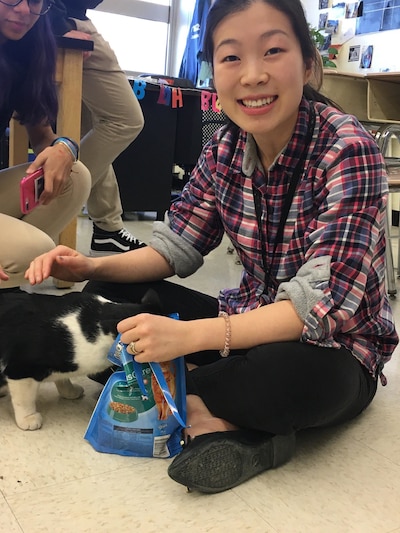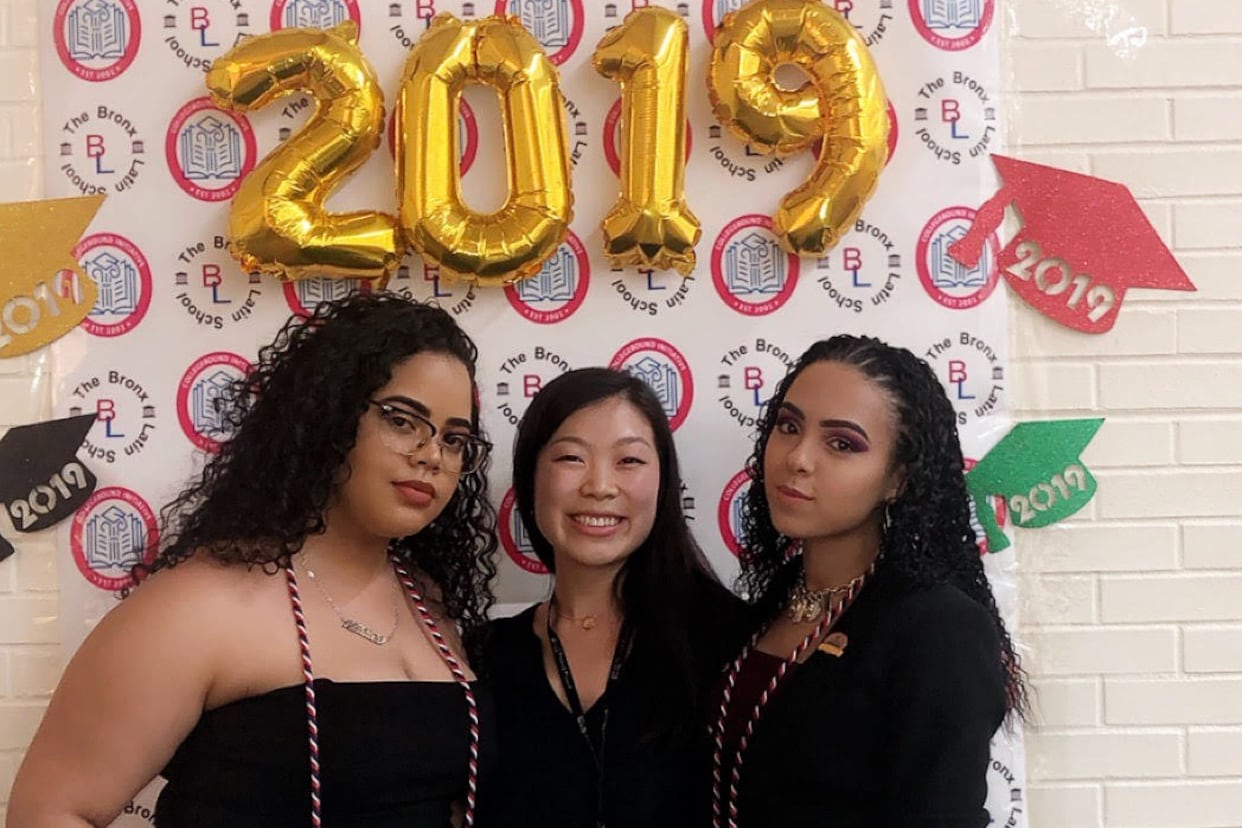Over the past year, Nancy Yeh has walked alongside her high school students through the death of loved ones, financial pressures, housing insecurity, and the mental load of their navigating formative years during a pandemic.
“The pandemic has ripped through our community,” said Yeh, an MIT graduate who teaches algebra, calculus, and English as a new language at Bronx Latin in New York City. “[I know] students with abusive or absent parents, students who were homeless, students in foster care, students who had to work illegal 12-hour shifts after school just to help support their family.”
Despite the toll, Yeh wants people to stop calling the period of learning on screens “lost.”
“I’ve had kids tell me that they feel like this school year is a waste because everyone around them says so,” she told Chalkbeat. “We’ve established a nice camaraderie in class, with lots of joking in the Zoom chat and learning on the Zoom screen. My AP Calculus kids are learning as much math as they would be in person.”
Yeh was one of more than 275 educators, parents, and students who wrote into Chalkbeat when we asked our readers in New York City and Newark to tell us how the pandemic impacted their school communities as part of our partnership with Univision called Pandemic 360.
A fourth-year teacher, Yeh spent the past year frantically adjusting to virtual-only learning before switching again to a hybrid of in-person and virtual classes.
Yeh spoke with Chalkbeat about how she fostered community in her virtual classroom, how the pandemic has exacerbated inequities in her school community, and what mental health and learning supports she hopes schools add given the hardships of this year.
This interview has been lightly edited for length and clarity.
Was there a moment when you decided to become a teacher?
I worked at an educational non-profit while I was in college and loved the experience, but never thought about actually becoming a teacher until I started working full time. I was in investment banking, and while I was really lucky and had a wonderful team, I just found the work a bit dull. I wanted to do something impactful for my community, I’d always adored my teachers and loved school, and I’ve always found kids hilarious and cute, so I joined the New York Teaching Fellows.
When you wrote to Chalkbeat, you mentioned a number of challenges brought on by the pandemic — exhaustion, stress, and having to fundraise for your own protective gear. What has helped you navigate this season both personally and professionally?
I just take each day at a time. I have a really amazing assistant principal running the school in person and other great colleagues in the building who’ve kept me sane. Major shoutouts, by the way, to our school custodial team, our school safety team, our cafeteria workers, and our guidance counselors. My husband has been my rock this entire time, and my best friend is an ICU doctor in Brooklyn. Nothing provides more perspective than hearing about her day at the ICU. My cat is a jerk, but sometimes he’ll let me pet him when I’m having a rough day.
You told Chalkbeat: “Roughly 70% of my students are thriving.” What has made some students thrive with online learning? How did you establish that camaraderie in your classroom?

I asked my students this exact question, and the general consensus is that being online, in their own rooms, means they can focus on class without distractions. Their friends aren’t whispering to them about the latest drama, the boy they have a crush on isn’t smiling at them from across the classroom. I record my classes, so they can go over the work later and learn at their own pace if they don’t finish something during class time. Online tests are open notes, which helps ease the anxiety over test-taking.
However, they’ve all also reported a lot of loneliness — being at home all day may make it easier to study, but not to make friends. This year, we started a freshman advisory class. We dedicate 45 minutes each Monday and Wednesday to different topics around social-emotional learning and civil activism. We also watch documentaries together (“The Social Dilemma” was a big hit!) with a running chat commentary. We also did a lot of community bonding exercises. I would send the kids into breakout rooms on Zoom and have them type in a Google Document answers to questions like: ‘What makes each person special?’ or ‘Why I’m grateful for ____’. Since everyone got a shoutout, no one felt left out — and since it was typed anonymously, students were less embarrassed to share deeper, more meaningful things.
You mentioned that even before the pandemic your school didn’t have the resources it needed. How have you seen those inequities exacerbated during the past year or so?
The first and most obvious inequity is our school building itself. During my first year of teaching, a portion of the ceiling in my classroom crumbled onto a row of (fortunately) empty desks. We share a building with a charter school and another public school. Our science classrooms don’t have functioning gas burners so we can’t do the fun and informative labs that I did in high school — not that we had the resources for stocks of chemicals and chemistry equipment anyway. We are chronically understaffed and are unable to retain good teachers, who feel overwhelmed having to teach five to six classes of 30-34 students every day. We fundraised for everything — I started a food pantry during the government shutdown in 2019 when families received their February food stamps in mid-January and had to make them stretch until March.
This was just in the school building, of course. Students had their own struggles at home, which we often had to navigate around during the school day. There were students with abusive or absent parents, students who were homeless, students in foster care, students who had to work illegal 12-hour shifts after school just to help support their family (a major issue with my seniors), students who were chronically hungry, gang violence, students who had family members or loved ones who were incarcerated, students who served as child care providers for younger siblings.
All needed different emotional and academic and social support within the classroom and from our counselors and paraprofessionals. Unfortunately, our counselors are also stretched thin — we have two high school counselors servicing nearly 400 students and one middle school counselor servicing over 200 students.
How do you feel your school community has supported students struggling with loss of loved ones or financial trials?
We have wonderful guidance counselors and a parent coordinator who worked harder than ever during this pandemic, making frequent home visits and even dropping off groceries. The cafeteria workers have been here every single day, preparing breakfast and lunch that anyone in the community can pick up after the students have been served. Teachers, like myself, simply provided as much love and support as we could. A lot of students have my phone number and will message me just to chat.
What specific mental health and learning supports do you want to see schools add, given the hardships of this year?
We need smaller class sizes, period. The only way to get smaller class sizes is to hire more teachers and build more schools and classrooms. I understand that this is incredibly costly, so I doubt it’ll happen, but it would make it so much easier for teachers to differentiate learning supports within the content material and also get to know each student on a personal level.
Perhaps more reasonable requests would be to hire more school counselors and psychologists, provide funding for after-school tutoring or Saturday sessions, provide funding for non-academic extracurriculars, and partner with local non-profits to come in and run a cooking club or a gardening club or a photography course. We could also start scheduling a regular advisory session at least twice a week so students can ease back into socializing with each other in a non-academic environment, with an advisory curriculum that focuses on social-emotional skills such as managing strong emotions, staying motivated, and connecting with peers in healthy ways.
Tell us about your own experience with school and how it affects your work today.
I’ve always loved school. I moved to Canada from China as a young child, so English was my second language, but I had the most loving and supportive teachers from elementary through middle school who made me feel welcome and at home. We moved again, from Canada to the United States, for the latter half of middle school and high school. I had a terrific experience there as well. My teachers were brilliant, and I had incredible resources available to me. I thrived academically and went to MIT for college, where I had even more resources at my fingertips and was surrounded by literal geniuses. I’ve also tried to give my students access to the same (or similar) resources that I had access to as a teenager: with my principal, I applied for and received a $20,000 grant to start a robotics club.
My peers, teachers, and professors all inspired me to learn and to love learning, and I bring that love of learning to my classroom every day.
Chalkbeat produced this Pandemic 360 series in partnership with Univision 41.







